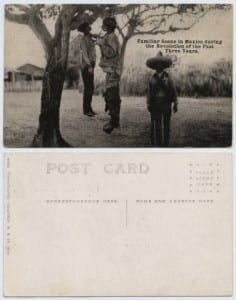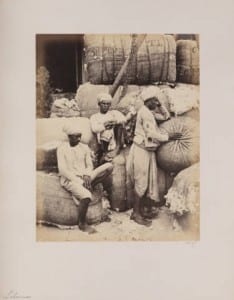 The picture Familiar Scene in Mexico during the Revolution of the Past Three Years created in 1913 captures 3 males, 2 of whom have been lynched and the third, an armed, presumably Mexican soldier, who seems to be either responsible for their lynching or guarding their bodies. The image is with woods and a home in the background of the large tree from which the two boys are hanging. Although the image itself is a depiction of a gruesome murder, the casual setting of the image contributes to the common place mood of the picture, which supports the picture’s title claiming the scene as being familiar. The lynched boys appear to have been poverty stricken as they are extremely thin and dressed in tattered clothing. The lynching itself seems to have been an attempt to send a message because the boys’ lifeless bodies were left hanging. Additionally, one of the boys has had his pants degradingly pulled down leaving his corpse appearing even more desperate and helpless in his already dilapidated state.
The picture Familiar Scene in Mexico during the Revolution of the Past Three Years created in 1913 captures 3 males, 2 of whom have been lynched and the third, an armed, presumably Mexican soldier, who seems to be either responsible for their lynching or guarding their bodies. The image is with woods and a home in the background of the large tree from which the two boys are hanging. Although the image itself is a depiction of a gruesome murder, the casual setting of the image contributes to the common place mood of the picture, which supports the picture’s title claiming the scene as being familiar. The lynched boys appear to have been poverty stricken as they are extremely thin and dressed in tattered clothing. The lynching itself seems to have been an attempt to send a message because the boys’ lifeless bodies were left hanging. Additionally, one of the boys has had his pants degradingly pulled down leaving his corpse appearing even more desperate and helpless in his already dilapidated state.
 The picture Lohannas by William Johnson captured between 1855-1862 pictures three men who seem to be resting amongst large, numerous bags of cotton. The men appear to be Sikh because of their head dress, also they are fully clothed and one of them is even wearing a pair of shoes. This in combination with the the fact that the men appear to be well nourished leads me to the conclusion that these men made a decent living working with the cotton in the background. It is likely that these men were in this line of work, which seemed to be have provided them with a better life than their fellow natives, because they are Sikhs, and Sikhs were favored by the British following the The Great Rebellion of 1857. The cotton in this image is likely to be processed into textiles to be exported and sold all over Europe. This image leaves me with questions, two of which are what are these men’s specific roles in the processing and production of the cotton as well why there are only 3 men when there is such an abundant amount of cotton to be handled.
The picture Lohannas by William Johnson captured between 1855-1862 pictures three men who seem to be resting amongst large, numerous bags of cotton. The men appear to be Sikh because of their head dress, also they are fully clothed and one of them is even wearing a pair of shoes. This in combination with the the fact that the men appear to be well nourished leads me to the conclusion that these men made a decent living working with the cotton in the background. It is likely that these men were in this line of work, which seemed to be have provided them with a better life than their fellow natives, because they are Sikhs, and Sikhs were favored by the British following the The Great Rebellion of 1857. The cotton in this image is likely to be processed into textiles to be exported and sold all over Europe. This image leaves me with questions, two of which are what are these men’s specific roles in the processing and production of the cotton as well why there are only 3 men when there is such an abundant amount of cotton to be handled.
